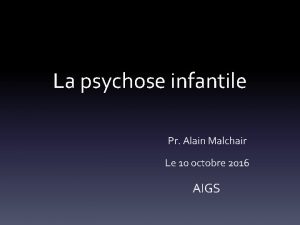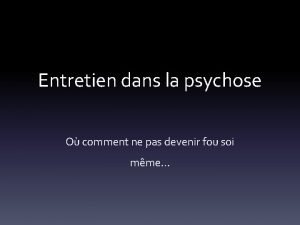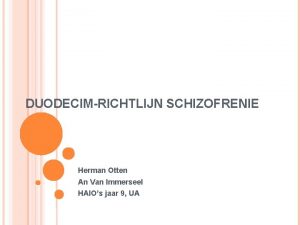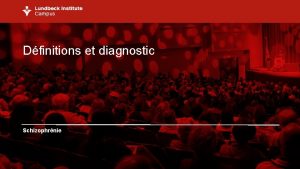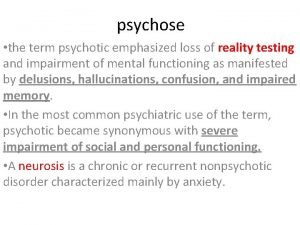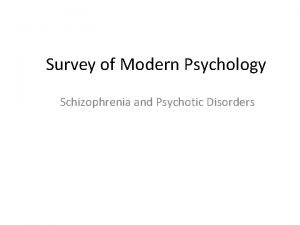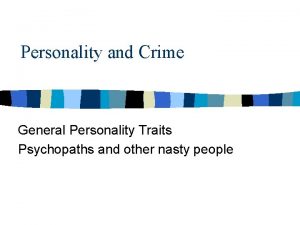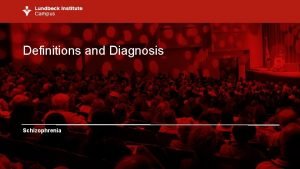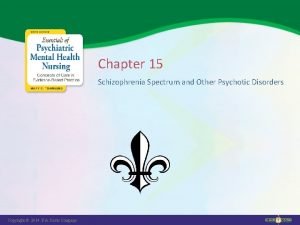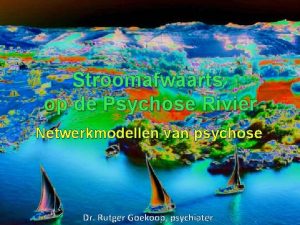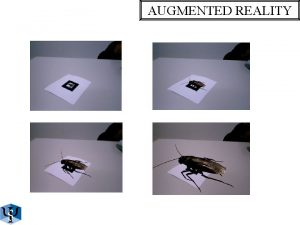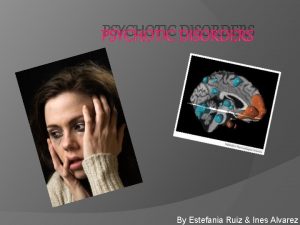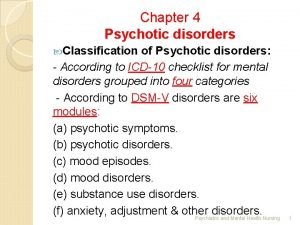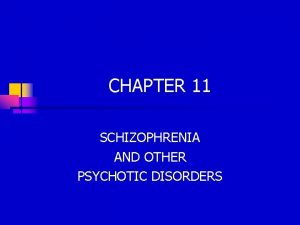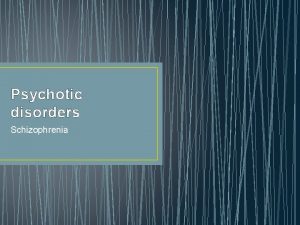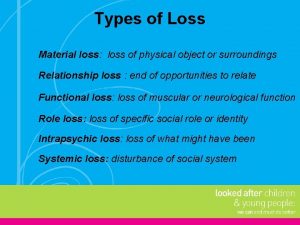psychose the term psychotic emphasized loss of reality















- Slides: 15

psychose • the term psychotic emphasized loss of reality testing and impairment of mental functioning as manifested by delusions, hallucinations, confusion, and impaired memory. • In the most common psychiatric use of the term, psychotic became synonymous with severe impairment of social and personal functioning. • A neurosis is a chronic or recurrent nonpsychotic disorder characterized mainly by anxiety.

psychoses • • Schizophrenia Schizophreniform Disorder Delusional disorder Schizoaffective disorder Brief Psychotic Disorder MDD with psychotic feature BID with P. F. Substance induced psychotic disorder

Schizophrenia • Schizophrenia is a clinical syndrome of variable, but profoundly disruptive, psychopathology that involves cognition, emotion, perception, and other aspects of behavior. • the effect of the illness is always severe and is usually long lasting. • The disorder usually begins before age 25, persists throughout life, affects persons of all social classes • diagnosis of schizophrenia is based entirely on the psychiatric history and mental status examination

Epidemiology • the lifetime prevalence of schizophrenia is about 1 percent, • Schizophrenia is equally prevalent in men and women • Onset is earlier in men than in women. • The peak ages of onset are 10 to 25 years for men and 25 to 35 years for women. • Onset of schizophrenia before age 10 or after age 60 is extremely rare. • In general, the outcome for female schizophrenia patients is better than that for male schizophrenia patients

Etiology • There is a genetic contribution to schizophrenia. • The modes of genetic transmission in schizophrenia are unknown. • Prevalence of Schizophrenia in General population 1%, Child with one parent with schizophrenia 12%, Child of two parents with schizophrenia 40%, Monozygotic twin of a schizophrenia patient 47%. • schizophrenia results from too much dopaminergic activity in mesocortical and mesolimbic tracts.

Diagnosis • A. Characteristic symptoms: Two (or more) of the following, each present for a significant portion of time during a 1 -month period : – delusions – hallucinations – disorganized speech (e. g. , frequent incoherence) – grossly disorganized or catatonic behavior – negative symptoms • B. Social/occupational dysfunction: • C. Duration: Continuous signs of the disturbance persist for at least 6 months.


delusion • • persecutory, grandiose, religious, Somatic Control Reference thought broadcasting thought reading


hallucination • • • Auditory: command, third person Visual Tactile olfactory, and gustatory Illusions

Other symptoms • • Disorganized behaviors: bizzare / eating • • Catatonia • • Mutism • • Mannerism • • Inappropriate affect • • Negativism • • poorly groomed, fail to bathe • • Stereotypies: verbigeration • HOARDING rubbish • Flat affect • Loosening of associations Echolalia Impulsiveness, Violence, Suicide, Homicide poor insight Social withdrawal Poor function

Subtypes • • • Paranoid type Disorganized type Catatonic type Undifferentiated type Residual type

Prognosis • 20 to 30 percent of all schizophrenia patients are able to lead somewhat normal lives. • About 20 to 30 percent of patients continue to experience moderate symptoms, • 40 to 60 percent of patients remain significantly impaired for their entire lives

Treatment • • antipsychotic medications Psychotherapy Psychoeducation Hospitalization

psychoses • • Schizophrenia Schizophreniform Disorder Delusional disorder Schizoaffective disorder Brief Psychotic Disorder MDD with psychotic feature BID with P. F. Substance induced psychotic disorder
 Psychose
Psychose Alain malchair
Alain malchair Psychose
Psychose Psychose kenmerken
Psychose kenmerken Dfinitions
Dfinitions Comorbidits
Comorbidits Types of delusion
Types of delusion Psychopath personality traits
Psychopath personality traits Difference between psychosis and neurosis
Difference between psychosis and neurosis Dsm 5 vs dsm 4
Dsm 5 vs dsm 4 Types of psychotic disorders
Types of psychotic disorders Normal loss treatment in process costing
Normal loss treatment in process costing In the 1800s, charles lyell emphasized that
In the 1800s, charles lyell emphasized that President taft’s foreign policy emphasized
President taft’s foreign policy emphasized Quantitative management theory
Quantitative management theory The classical management viewpoint emphasized
The classical management viewpoint emphasized

